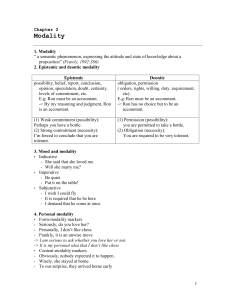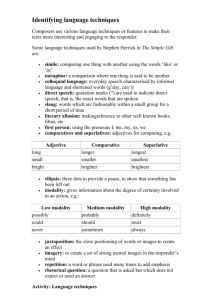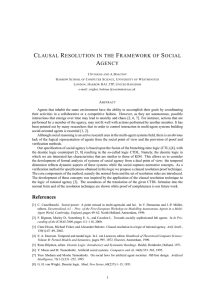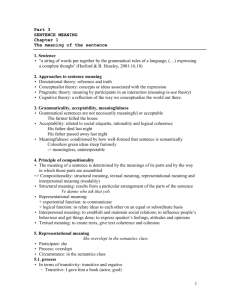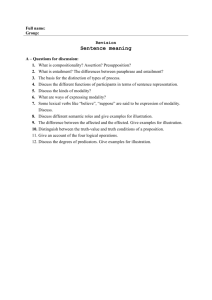The Author Perspective Model for Classifying Deontic Modality in Events
advertisement
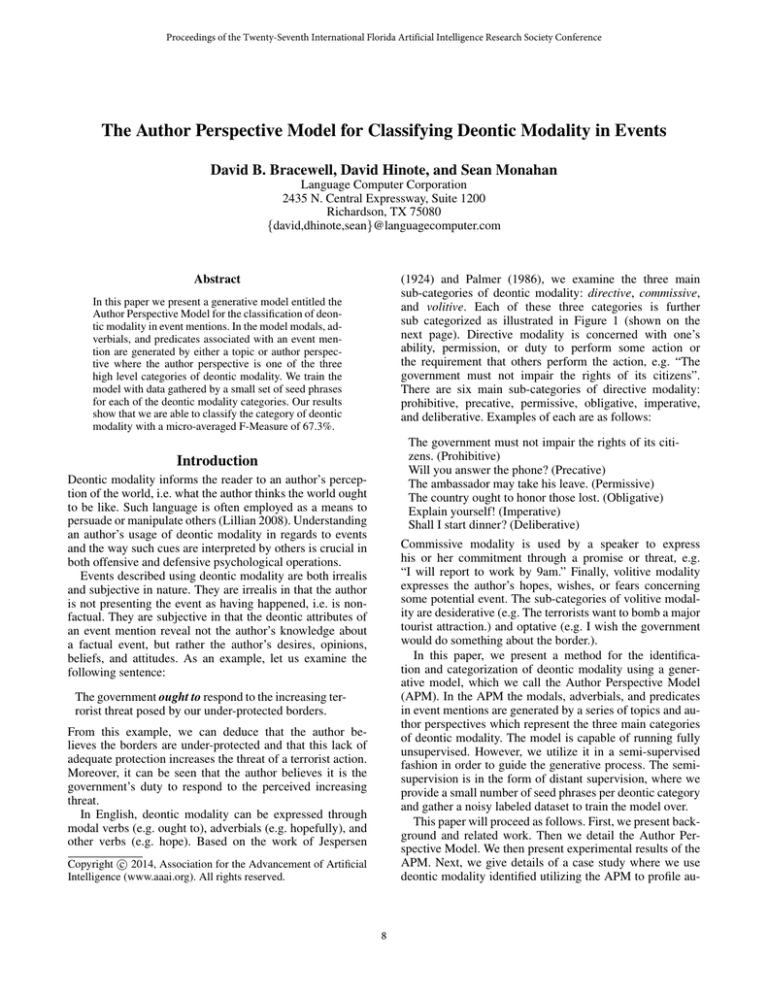
Proceedings of the Twenty-Seventh International Florida Artificial Intelligence Research Society Conference
The Author Perspective Model for Classifying Deontic Modality in Events
David B. Bracewell, David Hinote, and Sean Monahan
Language Computer Corporation
2435 N. Central Expressway, Suite 1200
Richardson, TX 75080
{david,dhinote,sean}@languagecomputer.com
Abstract
(1924) and Palmer (1986), we examine the three main
sub-categories of deontic modality: directive, commissive,
and volitive. Each of these three categories is further
sub categorized as illustrated in Figure 1 (shown on the
next page). Directive modality is concerned with one’s
ability, permission, or duty to perform some action or
the requirement that others perform the action, e.g. “The
government must not impair the rights of its citizens”.
There are six main sub-categories of directive modality:
prohibitive, precative, permissive, obligative, imperative,
and deliberative. Examples of each are as follows:
In this paper we present a generative model entitled the
Author Perspective Model for the classification of deontic modality in event mentions. In the model modals, adverbials, and predicates associated with an event mention are generated by either a topic or author perspective where the author perspective is one of the three
high level categories of deontic modality. We train the
model with data gathered by a small set of seed phrases
for each of the deontic modality categories. Our results
show that we are able to classify the category of deontic
modality with a micro-averaged F-Measure of 67.3%.
The government must not impair the rights of its citizens. (Prohibitive)
Will you answer the phone? (Precative)
The ambassador may take his leave. (Permissive)
The country ought to honor those lost. (Obligative)
Explain yourself! (Imperative)
Shall I start dinner? (Deliberative)
Introduction
Deontic modality informs the reader to an author’s perception of the world, i.e. what the author thinks the world ought
to be like. Such language is often employed as a means to
persuade or manipulate others (Lillian 2008). Understanding
an author’s usage of deontic modality in regards to events
and the way such cues are interpreted by others is crucial in
both offensive and defensive psychological operations.
Events described using deontic modality are both irrealis
and subjective in nature. They are irrealis in that the author
is not presenting the event as having happened, i.e. is nonfactual. They are subjective in that the deontic attributes of
an event mention reveal not the author’s knowledge about
a factual event, but rather the author’s desires, opinions,
beliefs, and attitudes. As an example, let us examine the
following sentence:
Commissive modality is used by a speaker to express
his or her commitment through a promise or threat, e.g.
“I will report to work by 9am.” Finally, volitive modality
expresses the author’s hopes, wishes, or fears concerning
some potential event. The sub-categories of volitive modality are desiderative (e.g. The terrorists want to bomb a major
tourist attraction.) and optative (e.g. I wish the government
would do something about the border.).
In this paper, we present a method for the identification and categorization of deontic modality using a generative model, which we call the Author Perspective Model
(APM). In the APM the modals, adverbials, and predicates
in event mentions are generated by a series of topics and author perspectives which represent the three main categories
of deontic modality. The model is capable of running fully
unsupervised. However, we utilize it in a semi-supervised
fashion in order to guide the generative process. The semisupervision is in the form of distant supervision, where we
provide a small number of seed phrases per deontic category
and gather a noisy labeled dataset to train the model over.
This paper will proceed as follows. First, we present background and related work. Then we detail the Author Perspective Model. We then present experimental results of the
APM. Next, we give details of a case study where we use
deontic modality identified utilizing the APM to profile au-
The government ought to respond to the increasing terrorist threat posed by our under-protected borders.
From this example, we can deduce that the author believes the borders are under-protected and that this lack of
adequate protection increases the threat of a terrorist action.
Moreover, it can be seen that the author believes it is the
government’s duty to respond to the perceived increasing
threat.
In English, deontic modality can be expressed through
modal verbs (e.g. ought to), adverbials (e.g. hopefully), and
other verbs (e.g. hope). Based on the work of Jespersen
c 2014, Association for the Advancement of Artificial
Copyright Intelligence (www.aaai.org). All rights reserved.
8
Figure 1: Categorization of deontic modality.
thors and groups. Finally, we give concluding remarks and
discuss future research directions.
a boarder set of acts, such as social obligations.
Recent work has examined social acts, which capture
the socio-cognitive processes that act on individuals during
communication. Social acts reflect the social intention of an
utterance and serve a function to inform about an individual’s social relationships. For example, in the statement “get
me a cup of coffee“, speech acts would focus on identifying
the set of actions that would result from the utterance - presumably the target of the utterance physically going to get
a cup of coffer for the speaker. In contrast, social acts focus
on the social implicature of the statement, that the speaker is
indicating their power over the target.
A number of recent approaches have examined the use of
specialized social acts in the inference of social implicatures.
Bracewell et al. (2011; 2012) examined a number of social
acts for inferring whether two dialogue participants have
a collegial relationship. Hassan et al. (2012) examined the
detection of subgroups based on social acts around stance
and attitude using signed social networks. Other research
has focused on the annotation and identification of social
acts. Tomlinson et al. (Tomlinson et al. 2012) examined the
manifestation of a set of social acts in Arabic for inferring
pursuits of power by participants. Bracewell et al. (2012)
created an annotated corpus of collegial and adversarial social actions. Bender et al. (2011) created an annotated corpus of social acts relating to authority claims and alignment
moves for determining authority and influence. Rosenthal
and McKeown (2012) examined methods for identification
of messages expressing opinionated claims.
Related Work
Modality and mood have been widely studied in the field of
linguistics (Palmer 2001). Modality has been closely studied for the role it plays in regards to tense and aspect (Bybee, Perkins, and Pagliuca 1994) and for its use in discourse
(Akatsuka and Clancy 1993; Bybee and Fleischman 1995;
Clancy, Akatsuka, and Strauss 1997). In the field of Computational Linguistics modality as it relates to events was
one of the areas of focus for the ACE (Automated Content
Extraction) program (Doddington et al. 2004) and the resulting ACE corpus (Walker et al. 2006). In ACE, modality
was defined as“asserted” and “other” with asserted modality
relating to when the author or speaker references an event
as a real occurrence. Modality was also the focus of a recent special issue in the Computational Linguistics journal (Morante and Sporleder 2012). In particular, a good
deal of focus was given to the factuality and veridicality
of events (de Marneffe, Manning, and Potts 2012; Sauri
and Pustejovsky 2012) and negation (Baker et al. 2012;
Velldal et al. 2012)
Deontic modality is closely related to speech acts, which
are actions performed by individuals when making an utterance. Austin (1962) formalized the concept of speech acts
by separating them into three classes: (1) locutionary, (2)
illocutionary, and (3) perlocutionary. Locutionary acts the
prosody, phonetics, and semantics of the utterance. Illocutionary acts are the intended functions of the utterances of
the speaker. Perlocutionary acts are illocutionary acts that
produce a certain effect in its addressee, e.g. scaring and insulting. Much of the work in speech acts has been focused on
illocutionary acts due to the work of Searle (1969). In particular, two categories of illocutionary acts that Searle defines
are directive and commissive which share the same definition as their modality counterparts.
Dialogue acts are specialized speech acts which include
the internal structure, such as grounding and adjacency
pairs, of a dialogue. There are a number of schemes for coding dialogue acts, such as DAMSL (Allen and Core 1997),
VERBMOBIL (Jekat et al. 1995), and DIT++ (Bunt et al.
2010). The DAMSL coding scheme defines dialogue acts
that are forward looking, which are extensions of speech
acts, and which are backward looking, which relate the utterance to previous utterances. Frameworks like DIT++ have
extended the typical coverage of dialogue acts to encompass
The Author Perspective Model
The identification and categorization of deontic modality is
done using a generative model in which the modals, adverbials, and predicates in event mentions are generated by a
series of topics and author perspectives. Our model which
is entitled the Author Perspective Model (APM) is inspired
by the work of Huang and Mitchell (2006) in that we have a
general topic, and provide means for feedback through making certain words “sticky” to a given author perspective. The
model performs inference over event mentions identified as
containing an instance of deontic modality. The graphical
representation of the Author Perspective Model is shown in
Figure 2.
The model assumes that each word (modal, adverb, or
verb) in an event mention is generated either by a topic (Z)
or an author perspective (P ). We define author perspective
as being related to the desires, hopes, and fears, i.e. deontic
9
φti (z) ≡ P (zi = z|ehk θt )
=
i
t
tz βzw
+(1−tz )βmwij
ij
i
P|Z| t Qni P|P | h t t
t
m=1 k βkw +(1−k )βmwij
j=1
k=1 πk
πzt
Qni P|P |
j=1
m=1
(3)
ij
ψit (p) ≡ P (pi = p|eh i θt )
=
i
t
tk βkw
+(1−tk )βlwij
ij
i
h
Qni P|Z| t t
P|L|
t
t
m=1 γl
j=1
k=1 k βkw +(1−z )βmwij
γlt
Qni P|Z|
j=1
k=1
(4)
ij
ρti (z) ≡ P (xij = 1 | zi = z, wij ; θt )
=
modality, expressed by the author in the communication. We
define a topic as general content being transmitted through
the communication and for which the author’s perspective
may be focused. A switching variable (X) is used to determine whether the word is a topic word or a perspective word.
The switching variable is used during inference to determine
the likelihood that a word (modal, adverb, or verb) is representing deontic modality or is general content (i.e. a topic).
More formally, given a corpus C of E event mentions
C = e1 , e2 , · · · , eE where ei is represented as a vector of
words {wij ; j ∈ 1, 2, · · · , ni } made up of the modals, adverbs, and predicates. We use the notation zi to represent
the value of the hidden topic variable Z, pi to represent the
value of the hidden author perspective variable P , and xi to
represent the value of the hidden variable X associated with
an observed word wi . The corpus likelihood of C given our
model θ is defined as:
QE P|Z|
P|P |
i=1
zi =1 P (zi )
li =1 P (pi )
Q
ni
[P
(x
=
1|z
)P
(wij |zi )
ij
i
j=1
+P (xij = 0|zi )P (wij |pi )]
(1)
t+1
βlv
P|P |
πi li =1 γi
+ (1 − )βpi wij ]
ni
j=1 [βzi wij
zi =1
PE
i=1
(6)
(7)
(8)
(9)
(10)
The Z and P variables represent clusters of words
(modals, adverbs, and verbs). The Z clusters represent topics found in the corpus whereas the P clusters are made up
of words that are manifestations of a particular author perspective, i.e. type of deontic modality.
The model as described now is fully unsupervised and
capable of learning sets of cue words for the categories of
deontic modality. In order to guide the generative process
into finding manifestations of specific categories of deontic
modality we add supervision. Supervision is incorporated in
two ways. First, a set of seed phrases are used to construct
a noisy set of training data. Second, using the noisy training
data a second set of seeds are learned and fixed to author
perspectives, i.e. we inform the model that certain phrases
are always generated by a specific author perspective. This
second set of seed phrases are “sticky” in that they have a
QE P|Z|
i=1
ij
φti (z)
E
PE t
γ (p)
γpt+1 = i=1 i
E
PE
Pni t
t
i=1 φi (z)
j=1 ρij (z)
t+1
=
PE
z
t
i=1 φi (z) · ni
PE
P
ni
t
t
i=1 φi (z)
j=1 δ(wij = v)ρij (z)
t+1
βzv
=
PS
P
ni
t
t
i=1 φi (z)
j=1 ρij (z)
PE P|Z| t
Pni
t
i=1
j=1 δ(wij = v)ρij (k)
k=1 φi (k)
=
PE P|Z| t
Pni t
i=1
j=1 ρij (k)
k=1 φi (k)
πzt+1 =
Rewriting the probability in terms of the model parameters results in the following:
P (C|θ)
Q=
ij
(5)
where φ is the probability of a topic given the event mention, ψ is the probability of an author perspective given the
event mention, and ρ is the probability that the word is generated by a topic. In this manner, the APM determines the
strength of the deontic modality in the given event mention
by updating ψ and φ which relate to the likelihood that the
event mention contains an expression of deontic modality or
is non-deontic. This is important as the data feed to the APM
is noisy and will contain sentences that do not have deontic
modality present.
The M Step for the Author Perspective Model uses the expected values (results of the E-Step) to maximize the probability of the corpus given the model. The M-Step is calculated as follows:
Figure 2: Graphical representation of the Author Perspective
Model.
P (C|θ) =
t
tz βzw
t
tz βzw
ij
P|P |
t
+ m=1 (1−tz )βmw
(2)
We can solve the equation using the expectation maximization (EM) algorithm (Dempster, Laird, and Rubin
1977). EM is a standard algorithm for determining the parameters of a model where the calculation of the parameters
depends on latent, or hidden, variables. EM works in an alternating fashion by first calculating the expected values (the
E step) of the parameters and then maximizing (the M step)
the likelihood of the values calculated in the E step.
The E Step for the APM is as follows:
10
As can be seen in Table 1 the Author Perspective Model
doubled the F-measure over the baseline. All three of the
categories performed well ranging in F-measure from 0.648
for Commissive to 0.710 for Volitive. In contrast, while
not directly comparable scores for speech acts associated
with directive modality, e.g. request, instruct, etc., have seen
scores ranging from 0.61 to 0.81 (Kang, Ko, and Seo 2013;
Petukhova and Bunt 2011). Scores for speech acts related to
commisive modality, e.g. promise, have scores ranging from
0.48 (Qadir and Riloff 2011) to 0.71 (Kang, Ko, and Seo
2013) F-Measure.
constant probability of 1.0 with the category for which they
are a manifestation.
Experimentation
To seed the APM we manually constructed a set of bigrams
(two word phrases) for each of the three deontic categories.
On average each category had 75 bigrams which included
automatically generated conjugations and related forms. Using the bigrams we extracted sentences from the Blog06 corpus (Macdonald, Ounis, and Soboroff 2007). From the sentences we extracted all event mentions and all tokens with a
modal, adverb, or verb part-of-speech attached via a depedency relation. We filtered the event mentions using a classifier that determined if the modality of the event mention
was “ASSERTED” or “OTHER” as defined by ACE.
The classifier we used was a maximum entropy model
which utilized a total of 36 features including, words around
the trigger, the presence and distance of modal words, part
of speech, dependency relations, presence of temporal arguments, sentence construction, polarity, genericity, tense,
and even the output of a rule based modality classifier.
Event mentions were only keep if the classified modality
was OTHER. In total, about 1 million event mentions were
extracted from the corpus. The extracted event mentions
were then used as the training corpus from which the APM
learned the likelihood that a word (modal, adverb, or verb)
belonged to a topic or author perspective (deontic modality).
Using the training corpus, we automatically extracted a
second set of seeds that we assigned as “sticky” to the author
perspectives. We determined these second set of seeds using
a log-likelihood test which is calculated as:
D = −2ln
L(θ0 )
L(θ1 )
Case Study: Iranian Elections
As a proof-of-concept, we analyzed English language tweets
around the Iranian elections in 2013. We focused on the
leadership of Iran, the eventual winner, and individuals supportive of the reform and mainstream political groups. In
particular, we collected tweets for the Supreme Ayatollah Ali Khamenei (2,460 in total), ex-President Mahmoud
Ahmadinejad (832 in total), and current President Hassan
Rouhani (1,335 in total). Additionally, we collected and aggregated tweets for other individuals into “Reform” (30,755
in total) and “Mainstream” (21,193 in total) political groups.
We employed the Author Perspective Model to identify
the three categories of deontic modality and “no deontic
modality” for each leader/group. We then filtered the tweets
to only those in which there was an expression of deontic
modality. This filtering facilitates examination of the difference in usage of the three categories of deontic modality between the leaders and political groups. Table 2 lists a breakdown of the percentage of tweets (rates of usage) for each
category of deontic modality for those tweets with a manifestation of deontic modality.
(11)
Khamenei
Ahmadinejad
Rouhani
Reform
Mainstream
where L(θ0 ) is the likelihood of the null model, i.e. a word
represents a manifestation of a particular author perspective
and L(θ1 ) is the likelihood of the alternate model, i.e. the
word does not represent a manifestation of an author perspective. We chose the top 10 phrases per author perspective.
To test the system, we manually constructed a test set of
150 event mentions, 50 per deontic category, from a political debate forum that was not a part of the Blog06 corpus. A
political debate forum was chosen as it has rich and varying expressions of deontic modality. The baseline performance (randomly selecting one of the three categories) on
our dataset is 33% F-measure. Table 1 lists the results for
the Author Perspective Model on the test set.
Commissive
Directive
Volitive
MICRO
Precision
0.614
0.673
0.750
0.673
Recall
0.686
0.660
0.673
0.673
Commissive
21.7%
24.0%
23.6%
21.8%
20.9%
Directive
41.8%
25.3%
41.9%
25.1%
21.8%
Volative
36.5%
50.7%
34.5%
53.1%
57.2%
Table 2: Results of the APM model.
The usage rates by themselves show difference, but are
not as informative as comparing the differences in the rate
of usage between groups. Therefore, we next examined the
difference in usage rates of the three categories of deontic
modality between the leaders and political groups. We determined if the difference was statistical significant by calculating the log-likelihood using G. The G is commonly used
when comparing differences in frequencies across two sets
of data, e.g. words usage in two different corpora. Table 3
illustrates the differences between the leaders of Iran and
the reform and mainstream political groups (bolded numbers with “*” represent a significant difference at p < 0.05).
As can be seen in Table 3 there were no significant differences in the usage of commissive modality (i.e. expressions
of commitment as a promise or threat) between any of the
individuals or groups. However, of possible interest is that
F-measure
0.648
0.667
0.710
0.673
Table 1: Results of the APM model.
11
Commissive
Khamenei
Ahmadinejad
Rouhani
Reform
Mainstream
Directive
Khamenei
Ahmadinejad
Rouhani
Reform
Mainstream
Volitive
Khamenei
Ahmadinejad
Rouhani
Reform
Mainstream
Khamenei
2.24%
1.91%
0.05%
-0.80%
Khamenei
-16.46%*
0.06%
-16.67%*
-18.60%*
Khamenei
14.21%*
1.97%
16.63%*
20.77%*
Ahmadinejad
-2.24%
-0.33%
-2.20%
-3.05%
Ahmadinejad
16.46%*
16.51%*
-0.22%
-3.51%
Ahmadinejad
-14.21%*
-16.18%*
2.42%
6.56%
Rouhani
-1.91%
0.33%
-1.87%
-2.72%
Rouhani
-0.06%
-16.51%*
-16.73%*
-20.02%*
Rouhani
-1.97%
16.18%*
18.60%*
22.74%*
Reform
-0.05%
2.20%
1.87%
-0.85%
Reform
16.67%*
0.22%
16.73%*
-3.30%
Reform
-16.63%*
-2.42%
-18.60%*
4.14%*
Mainstream
0.80%
3.05%
2.72%
0.85%
Mainstream
19.97%*
3.51%
20.02%*
3.30%
Mainstream
-20.77%*
-6.56%
-22.74%*
-4.14%*
-
Table 3: Differences in usage for (a) commisive , (b) directive, and (c) volitive modality between Iranian leaders and the
mainstream and reform political groups in Iran. Significant differences at p < 0.05 are indicated with an “*”.
the tweets by the reform and mainstream had on average
higher rates of commissive modality. The usage of directive (i.e. commands in which the author is requiring some
degree of conformity by the audience) and volitive modality (i.e. expressions of desires, wishes or fears) did have
a number of significant differences. The current and eventual Iranian leadership (Khamenei and Rouhani) had significantly increased usages of directive modality and asignificantly decreased usage of volitive modality compared to
ex-President Ahmadinejad and the two political groups. Interestingly, Khamenei and Rouhani did not have a significant
difference in their usage of deontic modality (across all three
categories). While the exact reason for this would require an
Iranian culture export, it does seem to suggest that a leader
in Iran must be in command and eliminate uncertainty (e.g.
hopes and fears).
ing the social relationships between individuals and groups.
Thus far we have reported numbers for identifying the
three major categories of deontic modality. In the future, we
will examine delving into the more fine grained categories
of deontic modality as illustrated Figure 1. Additionally,
we will focus on improving the performance of the APM
by constructing a development set with which we will tune
the APM’s parameters. The development set will be created
by identifying the deontic modality for sentences using the
APM and then having a human manually verify the result.
In this way, we should be able to quickly construct a sufficiently sized development set.
Acknowledgment
This material is based on research sponsored by the
Air Force Research Laboratory, under agreement number
FA8750-13-C-0078. The U.S. Government is authorized to
reproduce and distribute reprints for Governmental purposes
notwithstanding any copyright notation thereon.
Conclusion
In this paper we presented the Author Perspective Model
for the identification and categorization of deontic modality. The APM is a generative model in which modals, adverbials, and predicates associated with an event mention are
generated by either a topic or author perspective where the
author perspective is one of the three high level categories of
deontic modality. We trained the model with noisy data gathered by a small set of seed phrases for each of the deontic
modality categories. Our results showed that we were reliably able to classify the category of deontic modality with a
micro-averaged F-Measure of 67.3%.
In addition, we presented a case study around the Iranian elections where we used deontic modality to compare
and contrast individuals and groups. We found that there
were interesting differences between those in and those out
of power. While just scratching the surface, this analysis
showed potential for using deontic modality for understand-
References
Akatsuka, N., and Clancy, P. 1993. Conditionality and deontic modality in japanese and korean: Evidence from the
emergence of conditionals. Japanese/Korean Linguistics
2:177–192.
Allen, J., and Core, M. 1997. Draft of DAMSL: Dialog Act
Markup in Several Layers.
Austin, J. L. 1962. How to do things with words, volume 7
of The William James lectures. Harvard University Press.
Baker, K.; Bloodgood, M.; Dorr, B. J.; Callison-Burch, C.;
Filardo, N. W.; Piatko, C.; Levin, L.; and Miller, S. 2012.
Modality and negation in simt use of modality and negation
in semantically-informed syntactic mt. Computational Linguistics 38(2):411–438.
12
Huang, Y., and Mitchell, T. M. 2006. Text clustering with
extended user feedback. In Proceedings of the 29th annual international ACM SIGIR conference on Research and
development in information retrieval, SIGIR ’06, 413–420.
New York, NY, USA: ACM.
Jekat, S.; Klein, R.; Maier, E.; Maleck, I.; Mast, M.; Berlin,
T.; Quantz, J. J.; and Quantz, J. J. 1995. Dialogue acts in
verbmobil. Technical report.
Kang, S.; Ko, Y.; and Seo, J. 2013. Hierarchical speech-act
classification for discourse analysis. Pattern Recogn. Lett.
34(10):1119–1124.
Lillian, D. L. 2008. Modality, persuasion and manipulation
in canadian conservative discourse. Critical Approaches to
Discourse Analysis across Disciplines 2:1–16.
Macdonald, C.; Ounis, I.; and Soboroff, I. 2007. Overview
of the trec 2007 blog track. In TREC, volume 7, 31–43.
Citeseer.
Morante, R., and Sporleder, C. 2012. Modality and negation: An introduction to the special issue. Computational
Linguistics 38(2):223–260.
Palmer, F. R. 2001. Mood and modality. Cambridge University Press.
Petukhova, V., and Bunt, H. 2011. Incremental dialogue act
understanding. In Proceedings of the Ninth International
Conference on Computational Semantics, IWCS ’11, 235–
244. Stroudsburg, PA, USA: Association for Computational
Linguistics.
Qadir, A., and Riloff, E. 2011. Classifying sentences as
speech acts in message board posts. In Proceedings of
the Conference on Empirical Methods in Natural Language
Processing, EMNLP ’11, 748–758. Association for Computational Linguistics.
Rosenthal, S., and McKeown, K. 2012. Detecting opinionated claims in online discussions. In ICSC, 30–37.
Sauri, R., and Pustejovsky, J. 2012. Are you sure that this
happened? assessing the factuality degree of events in text.
Computational Linguistics 38(2):261–299.
Searle, J. R. 1969. Speech Acts: An Essay in the Philosophy
of Language. Cambridge University Press.
Tomlinson, M.; Bracewell, D. B.; Draper, M.; Almissour,
Z.; Shi, Y.; and Bensley, J. 2012. Pursing power in arabic on-line discussion forums. In Proceedings of the Eighth
Conference on International Language Resources and Evaluation.
Velldal, E.; Øvrelid, L.; Read, J.; and Oepen, S. 2012. Speculation and negation: Rules, rankers, and the role of syntax.
Computational linguistics 38(2):369–410.
Walker, C.; Strassel, S.; Medero, J.; and Maeda, K. 2006.
Ace 2005 multilingual training corpus. Linguistic Data Consortium, Philadelphia.
Bender, E. M.; Morgan, J. T.; Oxley, M.; Zachry, M.;
Hutchinson, B.; Marin, A.; Zhang, B.; and Ostendorf, M.
2011. Annotating social acts: authority claims and alignment moves in wikipedia talk pages. In Proceedings of the
Workshop on Languages in Social Media, LSM ’11, 48–57.
Stroudsburg, PA, USA: Association for Computational Linguistics.
Bracewell, D. B.; Tomlinson, M.; Shi, Y.; Bensley, J.; and
Draper, M. 2011. Who’s playing well with others: Determining collegiality in text. In Proceedings of the 5th IEEE International Conference on Semantic Computing (ICSC 2011).
Palo Alto: IEEE Computer Society.
Bracewell, D.; Tomlinson, M.; Brunson, M.; Plymale, J.;
Bracewell, J.; and Boerger, D. 2012. Annotation of adversarial and collegial social actions in discourse. In Proceedings
of the Sixth Linguistic Annotation Workshop, 184–192. Jeju,
Republic of Korea: Association for Computational Linguistics.
Bracewell, D.; Tomlinson, M.; and Wang, H. 2012. A motif approach for identifying pursuits of power in social discourse. In Semantic Computing (ICSC), 2012 IEEE Sixth
International Conference on, 1–8. IEEE.
Bunt, H.; Alexandersson, J.; Carletta, J.; Choe, J.-W.; Fang,
A. C.; Hasida, K.; Lee, K.; Petukhova, V.; Popescu-Belis,
A.; Romary, L.; Soria, C.; and Traum, D. R. 2010. Towards
an iso standard for dialogue act annotation. In LREC.
Bybee, J. L., and Fleischman, S. 1995. Modality in grammar
and discourse, volume 32. John Benjamins Publishing.
Bybee, J.; Perkins, R.; and Pagliuca, W. 1994. The evolution
of grammar: Tense, aspect, and modality in the languages of
the world. University of Chicago Press.
Clancy, P. M.; Akatsuka, N.; and Strauss, S. 1997. Deontic modality and conditionality in discourse. Directions in
functional linguistics 36:19.
de Marneffe, M.-C.; Manning, C. D.; and Potts, C. 2012.
Did it happen? the pragmatic complexity of veridicality assessment. Computational linguistics 38(2):301–333.
Dempster, A.; Laird, N.; and Rubin, D. 1977. Maximum
likelihood from incomplete data via the em algorithm. Journal of the Royal Statistical Society. Series B (Methodological) 1–38.
Doddington, G. R.; Mitchell, A.; Przybocki, M. A.;
Ramshaw, L. A.; Strassel, S.; and Weischedel, R. M. 2004.
The automatic content extraction (ace) program-tasks, data,
and evaluation. In LREC.
Hassan, A.; Abu-Jbara, A.; and Radev, D. 2012. Detecting subgroups in online discussions by modeling positive
and negative relations among participants. In Proceedings
of the 2012 Joint Conference on Empirical Methods in Natural Language Processing and Computational Natural Language Learning, 59–70. Jeju Island, Korea: Association for
Computational Linguistics.
13
